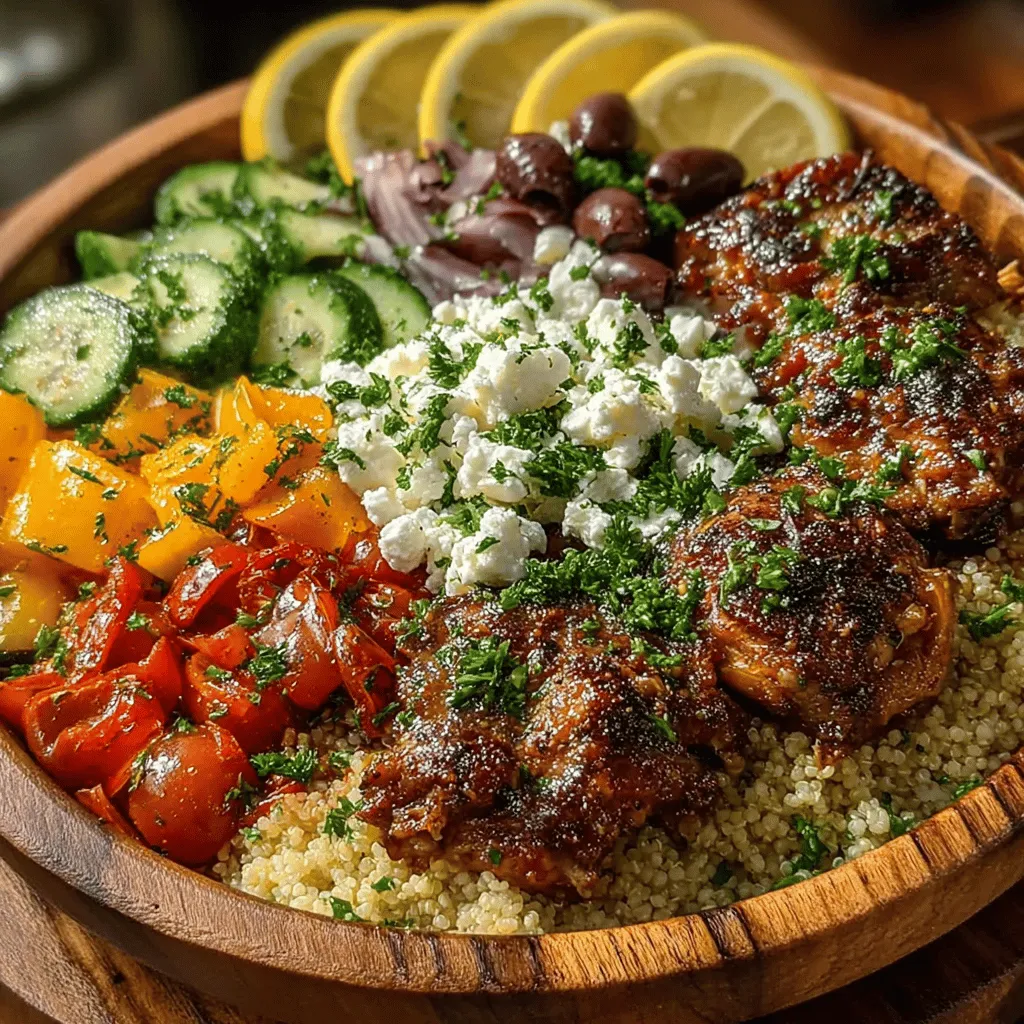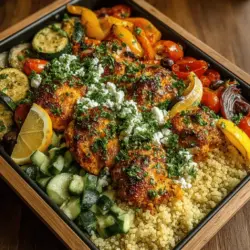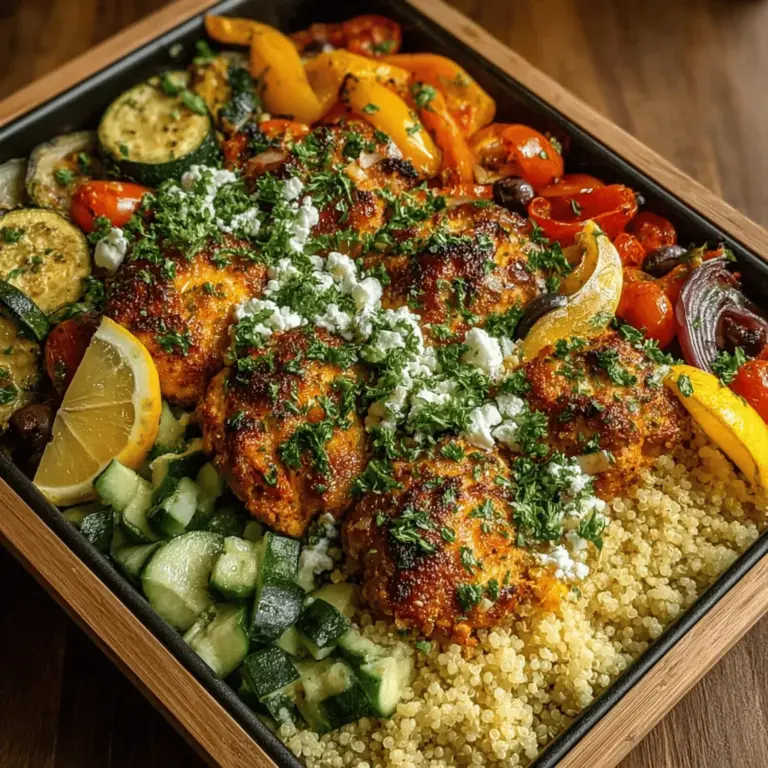Mediterranean Bliss: Sheet Pan Greek Chicken Bowls
Introduction
Mediterranean cuisine has long been celebrated for its vibrant flavors, fresh ingredients, and health benefits. This culinary tradition, inspired by the regions surrounding the Mediterranean Sea, focuses on wholesome, nutrient-dense foods that promote well-being and longevity. Rich in vegetables, whole grains, lean proteins, and healthy fats, Mediterranean dishes are not only delicious but also support a balanced lifestyle.
Among the myriad of recipes that encapsulate this culinary delight, the Mediterranean Bliss: Sheet Pan Greek Chicken Bowls stands out as a quick, nutritious, and flavorful dish ideal for busy weeknights. This recipe simplifies the cooking process, allowing you to enjoy a taste of the Mediterranean in just about 30 minutes. The sheet pan method not only saves time on cleanup but also ensures that all the ingredients meld together beautifully in the oven, creating a harmonious blend of flavors.
The appeal of a sheet pan meal lies in its practicality. With everything cooked on a single tray, you can easily prepare a wholesome dinner without the need for multiple pots and pans. This convenience is a game-changer for home cooks who want to provide their families with healthy options without sacrificing taste or spending hours in the kitchen.
Understanding the Ingredients
To create the perfect Mediterranean Bliss Sheet Pan Greek Chicken Bowls, it’s crucial to understand the ingredients that make this dish not only delicious but also nutritious. Each component plays a vital role in enhancing the overall flavor profile and health benefits of the meal.
Chicken Thighs
While chicken breasts often take the spotlight in many recipes, chicken thighs are the preferred choice for this dish. Thighs are more forgiving when it comes to cooking times, providing a juicier and more flavorful result. Their slightly higher fat content contributes to a rich taste, making them an ideal match for the bold Mediterranean flavors.
Olive Oil
A staple in Mediterranean cooking, olive oil is not only a key ingredient but also a source of healthy fats. Rich in monounsaturated fats and antioxidants, it supports heart health and provides a wonderful depth of flavor. In this recipe, olive oil plays a pivotal role in the marinade, helping to tenderize the chicken and infuse it with a savory richness.
Red Wine Vinegar and Dried Oregano
These two ingredients are essential for achieving the signature Mediterranean flavor. Red wine vinegar adds acidity and brightness, complementing the richness of the chicken. Dried oregano, known for its aromatic qualities, brings an earthy note that is quintessential to Greek cuisine. Together, they help to create a marinade that tantalizes the taste buds while enhancing the overall dish.
Fresh Vegetables
Incorporating fresh vegetables not only adds vibrant colors but also boosts the nutritional profile of the meal. Ingredients like red onion, cherry tomatoes, bell peppers, and zucchini offer a range of vitamins, minerals, and antioxidants. These colorful veggies contribute to a well-rounded dish that is as visually appealing as it is nourishing.
Quinoa or Brown Rice
As a base for the Greek chicken bowls, quinoa or brown rice provides a hearty and healthy foundation. Both options are excellent sources of whole grains, offering fiber, protein, and essential nutrients. Quinoa, in particular, is a complete protein, making it an ideal choice for those seeking a plant-based option. The use of these grains not only adds texture but also helps to absorb the flavorful juices from the chicken and vegetables.
Marinating the Chicken
One of the most crucial steps in preparing the Mediterranean Bliss Sheet Pan Greek Chicken Bowls is marinating the chicken. This process is essential for enhancing the flavor and tenderness of the meat. A well-crafted marinade allows the chicken to soak up all the delicious ingredients, resulting in a dish that bursts with flavor.
To prepare the marinade, follow these simple steps:
1. Gather Ingredients: Start by assembling your marinade ingredients: olive oil, red wine vinegar, dried oregano, minced garlic, salt, and pepper. Each of these components contributes to the overall flavor profile and helps to tenderize the chicken.
2. Mixing the Marinade: In a medium bowl, combine approximately 1/4 cup of olive oil with 2 tablespoons of red wine vinegar. Add 2 teaspoons of dried oregano, 3 cloves of minced garlic, and a generous pinch of salt and pepper. Whisk the ingredients together until well combined.
3. Marinating the Chicken: Place the chicken thighs in a large resealable plastic bag or a shallow dish. Pour the marinade over the chicken, ensuring that each piece is well coated. Seal the bag or cover the dish with plastic wrap and refrigerate.
4. Recommended Marinating Times: For the best results, marinate the chicken for at least 30 minutes. This allows the flavors to penetrate the meat. However, if you have more time, consider marinating overnight. A longer marination period will intensify the flavors, resulting in an even more delicious dish.
Preparing the Sheet Pan
Once your chicken has marinated to perfection, it’s time to prepare the sheet pan for roasting. Preheating the oven is a vital step in this process, as the right temperature ensures that your ingredients cook evenly and develop a beautiful caramelization.
1. Preheat the Oven: Set your oven to 425°F (220°C). This high temperature is ideal for roasting vegetables and chicken, allowing them to cook quickly while achieving that coveted crispy exterior.
2. Prepare the Vegetables: While the oven is preheating, wash and chop your vegetables into bite-sized pieces. Aim for uniform sizes to ensure even cooking. Combine the red onion, cherry tomatoes, bell peppers, and zucchini in a large bowl. Drizzle with a little olive oil and season with salt, pepper, and additional dried oregano if desired. Toss to coat the vegetables evenly.
3. Assemble the Sheet Pan: Line a large sheet pan with parchment paper for easy cleanup. Arrange the marinated chicken thighs on one side of the pan, allowing space for the vegetables. Spread the prepared vegetables on the other side, making sure not to overcrowd the pan. This will help them roast rather than steam, resulting in a more flavorful dish.
With the chicken marinated and the sheet pan ready, you’re well on your way to creating a delightful Mediterranean meal that will please both the palate and the body. The next steps will involve roasting the chicken and vegetables to perfection, but for now, enjoy the anticipation of a delicious dinner that brings the flavors of the Mediterranean right to your kitchen.

Tips for Lining the Sheet Pan for Easy Cleanup
One of the best practices when preparing a sheet pan meal is to line the sheet pan for effortless cleanup. Using parchment paper or aluminum foil not only makes for an easier post-cooking cleanup but also ensures that your ingredients don’t stick to the pan, preserving their flavors and textures. Here are some tips to optimize the lining process:
1. Choose the Right Material: Parchment paper is ideal for roasting vegetables and chicken since it’s non-stick and can handle higher temperatures. If you prefer aluminum foil, opt for heavy-duty foil to prevent tearing.
2. Pre-Cut the Liner: Before you start prepping your ingredients, cut the parchment or foil to fit your sheet pan. This will save time and ensure you have a perfect fit.
3. Grease the Liner: For an extra precaution against sticking, lightly spray or brush the lined pan with a bit of olive oil. This helps the chicken skin crisp up nicely while preventing any sticking.
4. Leave Overhangs: If you’re using foil, allow some excess to hang over the edges of the pan. This makes it easier to lift everything out after cooking. For parchment, folding the edges slightly can help it stay in place while cooking.
Arranging the Vegetables: Maximizing Flavor and Cooking Efficiency
The arrangement of vegetables on the sheet pan is crucial for both flavor and cooking efficiency. Follow these tips to ensure that each component cooks evenly and enhances the overall dish:
1. Cut Uniformly: Aim for similar sizes when chopping vegetables. This ensures they cook at the same rate, preventing some from becoming mushy while others remain undercooked.
2. Group by Cooking Time: Place harder vegetables, such as carrots and bell peppers, towards the edges where they can benefit from more heat. Softer vegetables, like zucchini and cherry tomatoes, should be placed more towards the center where the cooking time is shorter.
3. Season Generously: Before placing the vegetables around the chicken, toss them in olive oil, salt, pepper, and your choice of herbs. This not only maximizes flavor but also encourages caramelization during roasting.
4. Avoid Overcrowding: Leave space between your vegetables to allow for air circulation, which promotes even cooking and browning.
The Art of Layering: Placing Veggies Around the Chicken
When placing the vegetables around the chicken, consider the visual and flavor aspects of layering:
1. Visual Appeal: Arrange the vegetables in a colorful pattern. This not only makes for an aesthetically pleasing dish but also makes it easy to serve later.
2. Flavor Infusion: Position the vegetables in a way that allows them to absorb the juices from the chicken as it cooks. This will enhance their flavor and create a delicious base for your bowl.
3. Strategic Placement: Position denser vegetables like potatoes or carrots further from the chicken to avoid them becoming overly greasy while ensuring that the more delicate vegetables are nestled close to the chicken for optimal flavor absorption.
Baking the Chicken and Vegetables
Ideal Baking Time and Temperature for Perfect Results
For the best results with your Sheet Pan Greek Chicken Bowls, preheat your oven to 425°F (220°C). This high temperature is essential to achieve that perfect balance of crispy chicken skin and tender vegetables. Bake for approximately 25-30 minutes, or until the chicken is cooked through and the vegetables are tender and caramelized.
Signs That the Chicken is Properly Cooked (Internal Temperature Guide)
To ensure your chicken is fully cooked, use a meat thermometer to check the internal temperature. The USDA recommends that chicken be cooked to a minimum internal temperature of 165°F (75°C). Here’s how to check:
1. Insert the Thermometer: Place the thermometer in the thickest part of the chicken breast, avoiding any bones as they can give inaccurate readings.
2. Check Multiple Pieces: If you are cooking multiple chicken pieces, check the temperature of a few to ensure they are all properly cooked.
3. Resting Time: Allow the chicken to rest for a few minutes after removing it from the oven. This lets the juices redistribute, making for a juicier bite.
Understanding the Roasting Process: Caramelization and Flavor Development
Roasting at high temperatures not only cooks the chicken but also enhances the flavors of the vegetables through caramelization. This process involves:
1. Maillard Reaction: The browning that occurs on the surface of the chicken and vegetables creates complex flavors that elevate your dish.
2. Sweetness from Caramelization: As the natural sugars in the vegetables break down, they become sweeter, adding depth to your meal.
3. Flavor Concentration: The roasting process reduces moisture in the vegetables and chicken, concentrating their flavors and enhancing the overall taste experience.
Assembling the Bowls
Techniques for Slicing Chicken to Maintain Juiciness and Presentation
Once the chicken is cooked, it’s time to slice it for the bowls. Here’s how to do it effectively:
1. Rest Before Slicing: As mentioned earlier, allow the chicken to rest for a few minutes. This keeps the juices inside, preventing them from spilling out when you cut.
2. Slice Against the Grain: Identify the grain of the meat and slice against it. This results in tender pieces that are easier to chew.
3. Consider Thickness: Aim for slices that are about 1/2 inch thick for optimal presentation and ease of eating.
Layering Ingredients in the Bowls: How to Create a Balanced Dish
Creating a balanced bowl is key to a delicious meal. Follow these steps to layer your ingredients effectively:
1. Start with a Base: Begin with a generous scoop of quinoa or rice at the bottom of each bowl. This acts as the foundation and helps soak up any juices from the chicken and vegetables.
2. Add the Chicken: Place sliced chicken on top of the grains, allowing the juices to drizzle down and flavor the base.
3. Layer with Vegetables: Arrange the roasted vegetables around the chicken. Use the color and texture of the vegetables to make the dish visually appealing.
Importance of Layering Flavors: Quinoa/Rice, Chicken, Vegetables, and Toppings
To elevate the flavor profile of your bowl, consider the following:
1. Use Fresh Herbs: A sprinkle of fresh parsley or dill on top adds brightness and freshness to the dish.
2. Feta Cheese: Crumbled feta cheese provides a savory, creamy contrast to the roasted flavors.
3. Olives or Capers: For an added salty punch, include some olives or capers as a topping.
Suggestions for Garnishing with Herbs to Enhance Visual Appeal
Herbs not only enhance the flavor but also add a beautiful touch to your finished dish. Consider these options:
1. Chopped Parsley: A classic garnish that adds freshness and color.
2. Mint Leaves: For a refreshing twist, add torn mint leaves.
3. Basil: Fresh basil can impart a fragrant aroma and vibrant green color.
Serving Suggestions
The Importance of Acidity: How Lemon Juice Brightens the Dish
Lemon juice is a key element in Mediterranean cuisine, providing a bright acidity that balances the flavors of the dish. Squeeze fresh lemon juice over the assembled bowls just before serving to enhance the overall taste.
Pairing Options: Suggested Sides or Beverages That Complement the Meal
To round out your meal, consider pairing the Sheet Pan Greek Chicken Bowls with:
1. Greek Salad: A side of Greek salad with cucumbers, tomatoes, and olives complements the chicken and adds a refreshing crunch.
2. Tzatziki Sauce: This tangy yogurt sauce pairs perfectly with the flavors of the chicken and adds a creamy texture.
3. Wine Pairing: A crisp white wine, such as a Sauvignon Blanc, enhances the meal with its acidity and complements the Mediterranean flavors.
Storage Tips for Leftovers: How to Keep the Dish Fresh
If you have leftovers, here are some tips to keep them fresh:
1. Cool Down: Allow the dish to cool before storing it in airtight containers.
2. Refrigerate Promptly: Store leftovers in the refrigerator within two hours of cooking. They typically last for 3-4 days.
3. Freezing: For longer storage, consider freezing individual portions. They can be reheated directly from frozen, making for quick meals later.
Conclusion
The Sheet Pan Greek Chicken Bowls are a straightforward yet delicious way to enjoy a healthy Mediterranean-inspired meal. With vibrant flavors, wholesome ingredients, and minimal cleanup, this recipe exemplifies the joy of cooking at home. Not only do you reap the health benefits of fresh vegetables and lean protein, but you also experience the satisfaction of creating something special for yourself and your loved ones.
As you explore the versatility of Mediterranean cuisine, don’t hesitate to experiment with variations of this dish. Consider swapping out the vegetables, trying different grains, or adding your favorite toppings to make it your own. Cooking is a beautiful journey, and sharing homemade meals can create lasting memories around the table. Embrace the adventure of flavor, and enjoy every moment spent in the kitchen.

